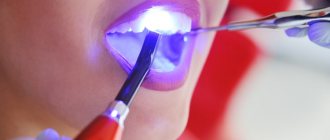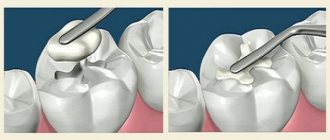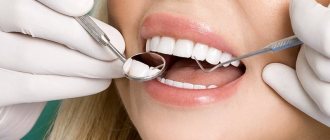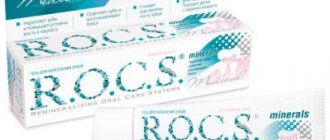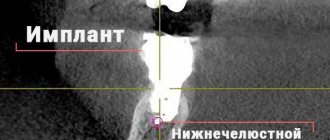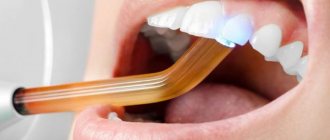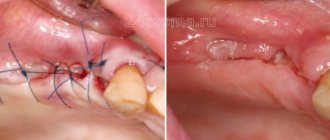Sometimes, after dental treatment, patients go to the dental clinic with a complaint of pain, not knowing that pain after some dental procedures is a normal phenomenon, and only in rare cases does it serve as a warning sign.
What causes pain after dental treatment and what to do in this situation?
If the filling interferes after treatment
Even in the doctor’s office, after installing the filling, be sure to make sure that the restored tooth is not in the way (move your jaw back and forth, sideways, carefully close your teeth). The filling should not be felt or change the bite. Don’t be shy about talking to your doctor about any discomfort—sometimes the final stage of filling treatment can take even longer than removing cavities and applying filling material.
After treatment, anesthesia wears off within 1.5-2 hours. If a conductor type was used, then after 4-6 hours. Now you are beginning to fully feel the treated tooth, you can fully close your jaws and understand how comfortable you are after filling.
If you experience slight discomfort, it feels like the tooth is a little larger and your jaws aren't closing quite tightly—this is normal. The fact is that now you have been given a new filling in accordance with the bite, that is, with the shape and position of the tooth located on the opposite side. The treated tooth became taller than before - after all, there was caries and the old filling sagged. Therefore, if there is no sharp pain and obvious rejection, be patient for a few days. If the situation normalizes and you get used to it, then there is no reason to see a doctor. If discomfort persists for 1-2 weeks, you should visit your dentist to have the filling corrected.
How long should you not eat after having a filling installed?
If a filling made of chemical composites is installed, then you should refrain from eating and drinking for 2 hours. This is due to the fact that the material requires a certain time for final shrinkage and hardening.
If a “light” composite filling is installed, you can drink immediately, but you should abstain from food for 1.5-2 hours. But the reason is not in the material (it hardens a few seconds after application), but in anesthesia - with reduced sensitivity of the mucous membranes during eating, you can injure the tongue and mucous membranes of the cheeks on the inside.
During the day after the filling is installed, you should only eat warm foods - excessively hot or cold foods can lead to changes in the shape of the filling. It is necessary to chew food on the opposite side for the first day - this will allow the material to fully “adhere” to the tissues and take the desired shape, without the risk of damage.
Why does a tooth hurt after a filling is installed?
Minor soreness may persist for several days or even a couple of weeks, which is explained by overheating of the tissue due to the use of boron. In some situations, for example, with deep caries or when treating front teeth, increased sensitivity can persist even for several months. But in such a situation, you should still consult a doctor for an x-ray to make sure that there is no infected tissue left under the filling and that inflammation has not affected the nerve.
If the pain intensifies, the filling darkens, black spots appear under it - all this indicates that the treatment was carried out poorly and re-inflammation has begun. This is a reason to see a doctor as soon as possible.
In what cases is pain in a pulpless tooth dangerous?
DentoSpas Clinic recommends contacting your doctor again if the following symptoms appear:
- the pain becomes sharp, throbbing, intensifies, does not weaken, and may be more pronounced at night;
- painkillers prescribed by the doctor do not work or relieve pain only slightly;
- there is sensitivity, discomfort when contacting cold;
- the patient has a fever and other symptoms of illness: weakness, headache;
- the gums become very swollen and inflamed;
- discomfort persists for a long time or returns some time after treatment (the tooth begins to hurt again).
These signs indicate complications of endodontic treatment. Pain may have several causes.
Reappearance of infection. Occurs if the infected tissue was not completely removed during the initial treatment. A source of infection remained inside the crown, under the filling, and tissue destruction continued.
Errors during filling. If the root canals are not filled tightly or completely, the voids remaining inside them threaten the re-development of infection. Microbes penetrate into them through surrounding tissues, causing inflammation. The pain comes from him. Another possible mistake is that the canals are not filled with filling material to the full depth. To exclude it, the DentoSpas clinic performs control radiography and uses an apex locator to assess the depth of the canals. There should be no voids left at the root apex after filling - this is dangerous due to the formation of granulomas and cysts, and destruction of hard tissues.
The filling material has gone beyond the root tip. This occurs if it is squeezed out through the apical foramen. Dental cement in this case hardens in the periodontal tissues, squeezing the nerves and impairing blood circulation. Because of this, inflammation begins and severe pain appears.
Perforation of the root walls. When cleaning root canals, the root walls may be perforated with an endodontic instrument. At the site of the hole, the tissue becomes infected and inflamed. When filling, perforation is dangerous due to the filling material leaving the root canal.
A fragment of the instrument remains inside the channel. This is a rare mistake. Such debris is clearly visible on control X-ray photographs. If they still remain inside the canal, it becomes clogged, making it more difficult to treat. Because of this, infected tissue remains at the root tip, which provokes re-inflammation.
Complications can arise not only due to treatment errors:
- allergy. Individual sensitivity to the components of the filling material or the medications used, their intolerance can provoke the appearance of pain, swelling, and discomfort immediately after treatment. Such symptoms do not go away on their own, they gradually intensify, and severe inflammation begins;
- damage to the adjacent tooth. The pain in it can spread along the gums and radiate into the pulpless tooth;
- trigeminal nerve injury. It occurs if it passes next to a pulpless tooth and was touched during its treatment. In this case, the pain is shooting, may be accompanied by numbness, and spread throughout the jaw.
What to do if your gums hurt after filling
The gums in the area where the anesthesia was administered may ache for several days - this is completely normal and does not require any measures. The mucous membrane may also be slightly inflamed if special rings were used during treatment, which are placed on the tooth to form the correct shape of its crown. The gums can also be damaged if the doctor had to install the filling material in close proximity to the mucous membrane or even under it - in such a situation the gums are deliberately pushed back. Therefore, pain is a normal reaction to external intervention.
All of these conditions are variations of the norm. But if the pain intensifies, redness and swelling of the mucous membrane progresses, you need to consult a doctor.
Why is temporary filling needed?
The need to use filling material is determined by the dentist. The installation of a temporary filling is prescribed by a doctor in the following cases:
- Carrying out diagnostics. When treating a patient with deep caries, a specialist is not always able to determine the extent of tissue damage. The doctor cleans the tooth cavity and places filling material. If the neurovascular bundle is not inflamed, then after the procedure the person will not experience pain. If the dental nerve and surrounding tissues are damaged, preliminary treatment will be required.
- Removal of the neurovascular bundle. In some cases, nerve sacrifice is required before removal. To do this, the dentist puts a specialized paste into the tooth cavity. After a certain period of time, the specialist removes the pulp and fills the tooth cavity with permanent filling material.
- Dental prosthetics. The dentist prepares teeth for prosthetics. To ensure that the root canals are protected from food and pathogenic bacteria during manufacturing, the specialist places a temporary filling material into the tooth cavity.
- Treatment of diseases. After treatment, the dentist places medications into the tooth cavity. After a certain period of time, the specialist removes the temporary filling and installs a permanent filling.
How to properly perform hygiene procedures
After treatment, brush the filled tooth carefully, applying minimal pressure to it. Do not use rinses containing abrasive substances and alcohol, which can increase the plasticity of the material - this will lead to a change in the shape of the filling. Also, do not use excessively hard brushes - they can leave microcracks in the material, which will quickly damage it.
In general, you should take care of teeth with fillings in a completely standard way:
- daily brushing of teeth twice a day - in the morning before breakfast and in the evening after all meals, after - rinsing the mouth with water and rinse,
- To clean the area of filled teeth after eating, it is better to replace dental floss with an irrigator. If you floss carelessly, you can touch the installed filling, especially if there are thin edges of the tooth, which will lead to its loss.
Why is tooth extraction required?
In certain cases, tooth extraction is the only possible method of solving a particular dental problem. Indications for removal may include:
- Incorrect position of the tooth, when neither the patient nor the doctor can access it (high-quality hygiene and/or treatment is impossible);
- The absence of the main part of the dental material without a chance of its restoration;
- Malocclusions (for example, severe crowding);
- Inflammatory process in the roots of the tooth, which can lead to infection;
- Painful eruption of wisdom teeth.
This is also necessary when preparing to correct your bite using Invisalign aligners. In particular, it is usually necessary to remove the “eights” if they have not fully erupted and can interfere with quality orthodontic treatment. It is worth noting that such a decision should be prepared when there are certain indications and no other option is possible.
Otherwise, when installing aligners, the unerupted tooth hidden inside the gum will prevent the aligner from attaching and pull the remaining teeth in the right direction, leaving them no room to move.
Is it necessary to follow a diet after caries treatment?
From the diet as a whole after caries treatment (especially if a large filling is installed and your own tooth has very thin walls), it is recommended to remove too hard foods - toffees, chewing gum, grilled fruit, nuts, etc. Or chew them with teeth located on the opposite side (if they do not have fillings).
Minimize the amount of consumed foods and drinks that contain coloring pigments (tea, coffee, beets) - under their influence, the filling material may slightly change its shade. This rule is especially relevant when restoring front teeth.
How to cope with pain?
In the fight against pain, it is not recommended to use untested folk remedies, especially if alarming symptoms develop. If you are not sure whether your feelings are normal, make an appointment with your dentist or consult with him by telephone.
To eliminate pain, special medications prescribed by the doctor are suitable. These most often include drugs from the group of non-steroidal anti-inflammatory drugs, for example, Ibuprofen, Nise, Nimesulide and others.
The medications are taken strictly according to the instructions and recommendations of the dentist. Additionally, cold compresses can be used.
How to maintain your treatment guarantee
As a rule, therapeutic treatment, that is, dental filling, is guaranteed from 6 months to 2 years - depending on the volume of work and the complexity of the situation. To maintain the guarantee, the patient must strictly follow all recommendations: do not overload the tooth, do not use it for other purposes (for example, open beer bottles), and also regularly see the doctor in accordance with the individual schedule of medical examinations. Unfortunately, many patients forget about this, and it is the last point that is the key to maintaining the guarantee for treatment.
You need to visit a doctor 1-2 times a year. During a preventive examination, the dentist will be able to make sure that the filling is in good condition and that caries does not develop again underneath it.
